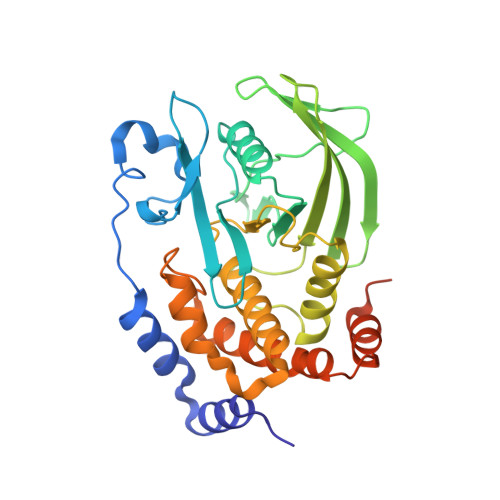Covalent Allosteric Inactivation of Protein Tyrosine Phosphatase 1B (PTP1B) by an Inhibitor-Electrophile Conjugate.
Punthasee, P., Laciak, A.R., Cummings, A.H., Ruddraraju, K.V., Lewis, S.M., Hillebrand, R., Singh, H., Tanner, J.J., Gates, K.S.(2017) Biochemistry 56: 2051-2060
- PubMed: 28345882
- DOI: https://doi.org/10.1021/acs.biochem.7b00151
- Primary Citation of Related Structures:
5T19 - PubMed Abstract:
Protein tyrosine phosphatase 1B (PTP1B) is a validated drug target, but it has proven difficult to develop medicinally useful, reversible inhibitors of this enzyme. Here we explored covalent strategies for the inactivation of PTP1B using a conjugate composed of an active site-directed 5-aryl-1,2,5-thiadiazolidin-3-one 1,1-dioxide inhibitor connected via a short linker to an electrophilic α-bromoacetamide moiety. Inhibitor-electrophile conjugate 5a caused time-dependent loss of PTP1B activity consistent with a covalent inactivation mechanism. The inactivation occurred with a second-order rate constant of (1.7 ± 0.3) × 10 2 M -1 min -1 . Mass spectrometric analysis of the inactivated enzyme indicated that the primary site of modification was C121, a residue distant from the active site. Previous work provided evidence that covalent modification of the allosteric residue C121 can cause inactivation of PTP1B [Hansen, S. K., Cancilla, M. T., Shiau, T. P., Kung, J., Chen, T., and Erlanson, D. A. (2005) Biochemistry 44, 7704-7712]. Overall, our results are consistent with an unusual enzyme inactivation process in which noncovalent binding of the inhibitor-electrophile conjugate to the active site of PTP1B protects the nucleophilic catalytic C215 residue from covalent modification, thus allowing inactivation of the enzyme via selective modification of allosteric residue C121.
Organizational Affiliation:
Department of Chemistry, University of Missouri , 125 Chemistry Building, Columbia, Missouri 65211, United States.

















